Surya (Sun) Namaskaram (Salutation) is the most commonly practiced yoga sequence by many Yoga traditions today. Although the sequence of Sun Salutation does not have any reference in ancient scripts, Surya Namaskaram is one of the main disciplines in the Hindu tradition and its principles are closely associated with the Indian System of Medicines such as Siddha and Ayurveda.
Traditionally, Hindus worship the sun every morning exposing their whole bodies to the rising sun. Later, this practice was formulated as a sequence of Yoga postures. Different traditions practice different variations of Sun Salutation. This ranges from 10, 12, 14 or even 16 steps. Although the number of poses does not matter, it can be modified according to the practitioner’s flexibility and strength. Many Yoga traditions such as Vinyasa yoga, Power Yoga start with Sun Salutation and modify the poses in the middle.
It is good if you can practice Sun Salutation facing the rising sun in the morning and the setting sun in the evening. Although Sun Salutation is a good start for Yoga practitioners as a self practice, people with injuries and medical conditions must practice it under expert guidance. Kids will enjoy this practice as it is fun to move around and easy to remember.
• Every month we will feature different variation of Sun Salutation and tips.
• This month sequence is focused towards the intermediate to advanced level yoga practitioners.
• As this sequence involves balancing, hip rotation and knee flexions, practice some warm-ups focusing on the hips and hamstrings, wrist stretches and shoulder strengthening poses regularly.
• Practice the first few rounds by holding each pose for 2 – 4 breaths and then slowly adapt the practice to one breath a movement.
• This sequence is suitable to improve body balance and improve overall body alignment. One can also enjoy toning and weight loss benefits.
• Start with the few rounds of a basic sun salutation sequence before practicing this intermediate level variation.
1. Vrksasana – Tree pose
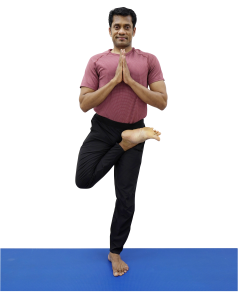
Step: Stand tall with the left foot on the floor, raise and bend the right knee and place the back of the right foot on the left thigh near the hip. Bring the palms in Anjali mudra in front of the chest and gaze forward.
Breathing: Normal Breathing
Awareness: Anahata Chakra
Benefits: Helps improve body awareness, physical and mental balance, and calms the mind.
2. Ekapada Ardha Chandrasana – Half Moon Pose
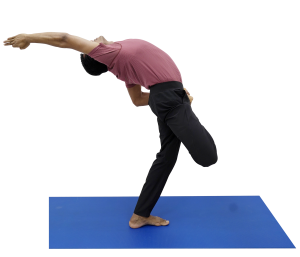
Step: Maintain the balance on the left leg with the left arm hold the left foot and as you inhale raise the chest up and right arm up over the head lengthen the spine up and arch the back.
Breathing: Inhale and as you exhale arch back
Awareness: Swadhisthana Chakra
Benefits: Strengthens and improves the flexibility of the spine. Improves circulation and rejuvenates the whole body.
3. Ekd pada hasta Uttanasana – Standing on one foot arms extending pose
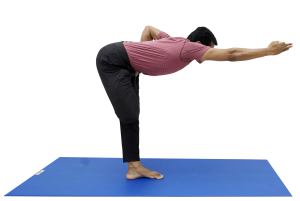
Step: Maintain the balance and slowly bend forward and left arm hold the right foot, keep the body parallel to the floor, stretch the right arm away from the shoulder and extend the spine.
Breathing: Exhale and as you inhale lengthen the spine
Awareness: Manipuraha Chakra
Benefits: Good stretch for the hamstrings. Improves hip flexibility and body balance.
4. Ardha Padma Padahasthasana – Half lotus, standing forward bend pose
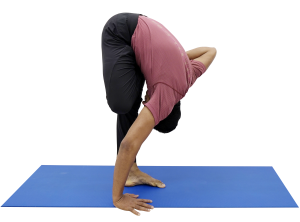
Step: Slowly bend forward and place the right palm on the floor and bring the forehead closer to the left knee. Lengthen the spine towards the floor.
Breathing: Exhale
Awareness: Swadhisthana Chakra
Benefits: Strengthens the legs and hips. Improves shoulders and upper back flexibility.
5. Vatayanasana – Sage Vatayana pose
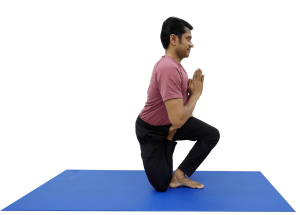
Step: Slowly place the right knee on the floor beside the left heel. Lengthen the spine and maintain the balance by gazing on one point. Press the palms in anjali mudra.
Breathing: Inhale
Awareness: AnahataChakra
Benefits: Improve flexibility of the knee and hips. Improves body balance.
6. Ardha Padma Parvatasana – Mountain Pose – Half Lotus variation
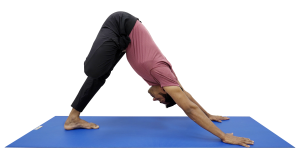
Step: Slowly place the palms on the floor, shoulder width apart, and raise the hips up higher and press the left heel down as much as possible. Lengthen the shoulders, arms and back towards the ceiling.
Breathing: Exhale
Awareness: Manipuraha Chakra
Benefits: Improves upperbody strength and stretches the left hamstring and calve muscles.
7. Ardha Padma Uthitha Dandasana – Raised plank – Half Lotus Variation
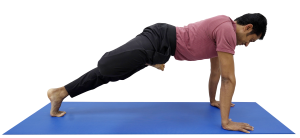
Step: Place the palms straight under the shoulders and jump back with the left leg and bring the body in on straight line. Maintain the knees parallel to each other.
Breathing: Inhale
Awareness: Mooladhara Chakra
Benefits: Improves the strength of the shoulders and arms. Strengthens the back and abdominal muscles.
8. Ardha Padma Nirakunjasana – Heart Pose – Half Lotus Variation
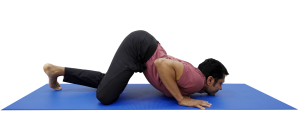
Step: Slowly place the knees , chest and chin on the floor. Maintain the palms beside the chest.
Breathing: Exhale
Awareness: Anahata Chakra
Benefits: Improves the flexibility of the upper back. Improves circulation to the heart and lungs.
9. Ardha Padma Bhujangasana
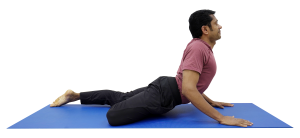
Step: Slide the body forward and arch the back as much as posible.
Breathing: Inhale
Awareness: Swadhisthana Chakra
Benefits: Improves flexibility of the spine and strengthen the back muscles.
10. Ardha Padma Uthitha Dandasana – Raised plank – Half Lotus Variation

Step: Place the palms straight under the shoulders and jump back with the left leg and bring the body in one straight line. Maintain the knees parallel to each other.
Breathing: Inhale
Awareness: Mooladhara Chakra
Benefits: Improves the strength of the shoulders and arms. Strengthens the back and abdominal muscles.
11. Ardha Padma Parvatasana – Mountain Pose – Half Lotus variation

Step: Raise the hips up higher and press the left heel down as much as possible. Lengthen the shoulders, arms and back towards the ceiling.
Breathing: Exhale
Awareness: Manipuraha Chakra
Benefits: Improves upperbody strength and stretches the left hamstring and calve muscles.
12. Vatayanasana – Sage Vatayana pose

Step: Slowly place the right knee on the floor beside the left heel. Lengthen the spine and maintain the balance by gazing on one point. Press the palms in anjali mudra.
Breathing: Inhale
Awareness: Anahata Chakra
Benefits: Improves flexibility of the knee and hips. Improves body balance.
13. Ardha Padma Padahasthasana – Half lotus, Standing forward bend pose

Step: Slowly bend forward and place the right palm on the floor and bring the forehead closer to the left knee. Lengthen the spine towards the floor.
Breathing: Exhale
Awareness: Swadhisthana Chakra
Benefits: Strengthens the legs and hips. Improves shoulders and upper back flexibility.
14. Ekd pada hasta Uttanasana – Standing on one foot arms extending pose

Step: Maintain the balance and slowly lift the torso up and left arm hold the right foot, keep the body parallel to the floor, stretch the right arm away from the shoulder and extend the spine.
Breathing: Exhale and as you inhale lengthen the spine
Awareness: Manipuraha Chakra
Benefits: Good stretch for the hamstrings. Improves hip flexibility and body balance.
15. Ekapada Ardha Chandrasana – Half Moon Pose

Step: Maintain the balance on the left leg with the left arm hold the right foot and as you inhale raise the chest up and right arm up over the head lengthen the spine up and arch the back.
Breathing: Inhale and as you exhale arch back
Awareness: Swadhisthana Chakra
Benefits: Strengthens and improves the flexibility of the spine. Improves circulation and rejuvenates the whole body.
16. Vrksasana – Tree pose

Step: Stand tall with the left foot on the floor and raise and bend the right knee and place the back of the right foot on the left thigh near the hip. Bring the palms in Anjali mudra in front of the chest and gaze forward.
Breathing: Normal Breathing
Awareness: Anahata Chakra
Benefits: Helps improve body awareness, physical and mental balance and calms the mind.
Yoga Demonstration by Master Keshav














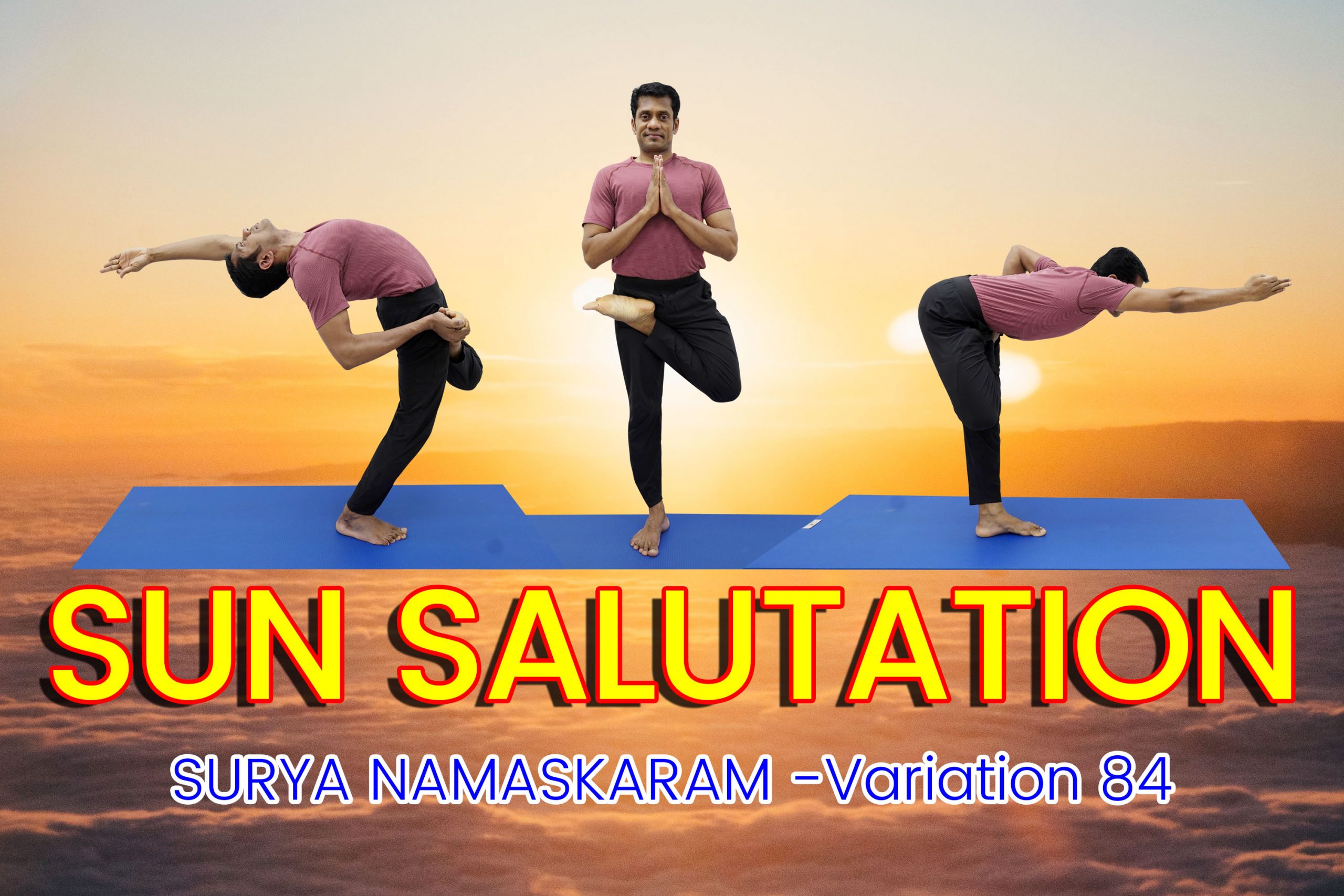



 Other
Other